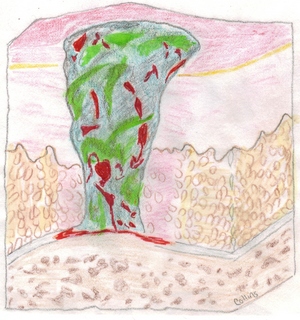The first time I saw a stage-four bed sore (decubitus ulcer) I was working at an Eastern Shore nursing home. When the nurse removed the dressing for wound care, the “sore” stretched from the bottom of the patient’s buttock halfway down the length of her thigh. Most of her tissue had been eaten away so that her thigh bone was clearly visible.
The second time I saw a stage-four decubitus ulcer was at a Baltimore nursing home. The patient, a male, had a hole on his sacrum that was as wide in circumference as your thumb and forefinger forming a circle; and deep enough to require at least a foot of wet dressing packed into the wound and left to dry.
Decubitus ulcers are lesions caused mostly from tissue being compressed when a patient lays in the same position for a long period of time. One factor that can hasten a bedsore to form is excess moisture from incontinence; a factor easily exacerbated by a taped up diaper.
And that’s where I come in. I’m a self-described Diaper Bandit.
During a daily unit staff huddle one morning, a nurse followed up my comment that I have “diaper issues” with “Yep she does; when she sees a patient with a diaper on she snatches it off.”
Definitely. I despise the use of diapers on adult patients; won’t use them if I don’t have to and snatch them off if they’re on from the previous shift.
It sounds disrespectful – of perhaps my co-workers or patients. But it’s really not. It’s my way of trying to prevent incontinent, non-ambulatory patients from getting painful, irritating skin breakdowns that can lead to even more painful decubitus ulcers.
I’m a nurse support tech – a.k.a. patient care tech, patient care associate – and I work in a hospital setting. In a nursing home I’d be a geriatric nursing assistant. Regardless of title, the bottom line is that I’m a certified nursing assistant whose basic job is to care for patients – a description with which diapers interfere in my opinion.
Diapers are a cotton/plastic combo – designed to absorb, contain and if left on too long, damage skin. In their defense, they do make life simpler and convenient for the caregiver of an incontinent individual: clean-up is a snap. Remove the soiled diaper in a timely manner, (i.e. as close to immediately after the patient soiled it as possible) and presto! No skin breakdown and no bedsores. In a perfect world.
In this world, particularly the short-staffed, overwhelmed, stressed health-care world, diaper use on incontinent patients is a convenience for the nursing staff but a nightmare for the patient.
When a unit is operating with, for example, one nurse support tech, 15 patients (at least three who are incontinent), nurses already overwhelmed with supervising the minute details of the patients in their care, and an entire nursing staff trying to just get through the rigors of a 12-hour shift without becoming a patient – who has time to continually change sheets and bathe undiapered, incontinent patients wiggling around in their own excrement? Slap a diaper on them; maybe even two at the same time. That way when the patient voids or releases their bowels nursing staff zip in when able; clean that one contained area, slap another diaper on and zip out. It could work right? No not so much. What happens is that the overwhelmed, short-staffed nurses and techs don’t always re-check patients in a timely manner, and skin breakdown starts.
So, Why Use A Diaper?
Reason #1: The patient requests it – This is the only time I feel somewhat comfortable with using a diaper – either the hospital’s or the pull-ups patients bring from home. Those who ask for them are alert and mobile enough to ask for help immediately when they’re soiled; or remove the soiled diaper themselves. No skin issues here.
Reason #2: Not enough staff – Not the best reason for use but containment makes cleanup easier. Particularly at night and on weekends, staff-to-patient ratio may come up short in hospitals and nursing homes because they aren’t popular shifts. However, that doesn’t lessen patient care needs or the amount of work required to meet those needs. To ease the stress of caring for numerous patients, diapers are the perfect quick fix. They’re designed to absorb and contain and they work – for us. But if the nursing staff is so busy that they are having trouble getting to all the patients, how easy will it be for them to double back and change a diapered patient in a timely manner? And what happens to the patient’s skin when they don’t double back when they should?
Reason #3: The patient urinates buckets or has diarrhea – Once again, containment makes cleanup much easier. But doubling back in a timely manner becomes even more important with a patient like this. And when the unit is short-staffed, not doubling back immediately means the patient will get short-changed. To address this, nursing assistants in nursing homes devised a method they thought took care of the problem, though I don’t agree. On a patient like this one, not one, but TWO diapers are taped on their bottom; the idea being that when the one closest to the skin gets soiled, it is removed and there’s another diaper already there. Since I know this job, I don’t see the point. It doesn’t make our job any easier; rather, it doubles the damage done to the patient’s skin which now has urine and/or feces trapped inside of two layers of plastic for hours at a time.
The whole idea of a diaper is that the incontinence is contained; yayyy for nursing staff! But contained translates to out of sight, which unfortunately lowers its importance on the priority list of an overwhelmed, under-staffed nursing unit or nursing home. If the patient’s bedding or gown isn’t wet during rounds, priority goes to the next task. But just like with the cheaper brand of baby diapers, one good soaking is all these hospital diapers can handle and the wetness is flush against the patient’s skin. If it’s not changed as soon as possible, what’s that doing to the patient’s skin? And I haven’t even mentioned the importance of turning the patient every two hours as is required for immobile patients, which if followed would protect the patient because hopefully the diaper would get changed then.
And for clarity, I’m not saying that it’s okay to just place a waterproof pad under the patient’s naked bottom and let them marinate in their own waste either. But at least without the diaper pressing urine and feces to their skin, there’s a chance that the patient won’t experience any breakdown or pain.
Diaper damage on an adult patient is just as painful as it is on a baby whose diaper is not getting changed in a timely manner. Wiping their behind to clean them hurts; soap and cleansers sting; they end up enduring more pain in an already sensitive area than they should have to.
That’s why I snatch diapers. Short of waving a magic wand, I can’t do anything about the staff shortage; and I’m aware that my 12-hour shift, 36 hours a week may not account for much in the long run. But I feel good about it.


